Submitted:
18 July 2023
Posted:
19 July 2023
You are already at the latest version
Abstract
Keywords:
1. Literature Review
1.1. Rare Earth Elements
1.2. Magnetic Separation
- (1)
- the strength of the magnetic field,
- (2)
- the degree of loosening of the material layer fed to the separator,
- (3)
- the magnetic susceptibility of the material,
- (4)
- the size of the grains,
- (5)
1.3. Research Carried out by ITG KOMAG Related to REE
- (1)
- hard coals - analyses of type 31 thermal coal showed cerium content of 27.2 ppm (2019) [3],
- (2)
- mining wastes - analyses of wastes constituting coal slurries showed a scandium content of 33.4 ppm (2020) [5],
- (3)
- power plant energy waste - analyses of fly ash and power plant slags showed a cerium content of 34.0 ppm and yttrium content of 29.6 ppm (2019) [6],
- (4)
- energy waste from landfills - analyses showed a neodymium content of 47.76 ppm (2020) [9],
- (5)
- metallurgical waste - analyses of waste from sludge tanks showed a neodymium content of 17.3 ppm (2022) [21],
- (6)
- (7)
- electronic waste - studies to determine the contribution of REE and attempts to recover elements from hard drives and wind turbine components (unpublished research).
2. Materials and Methods
- (1)
- granulometric classification and grinding,
- (2)
- magnetic separation,
- (3)
- analysis of REE content by ICP-MS for the obtained products of granulometric classification and magnetic separation.
2.1. Granulometric Classification
- (1)
- >2.0mm.
- (2)
- 2.0–1.0mm.
- (3)
- 1.0–0.5mm.
- (4)
- 0.5–0.25mm.
- (5)
- 0.25–0.125mm.
- (6)
- 0.125–0.063mm.
- (7)
- 0.063–0.045mm.
- (8)
- <0.045mm.
- P1 – coal slurries in the class >2.0 mm.
- P2 – coal slurries in the class <2.0–1.0 mm.
- P3 – coal slurries in the class <1.0–0.5 mm.
- P4 – coal slurries in the class <0.5–0.25 mm.
- P5 – coal slurries in the class <0.25–0.125 mm.
- P6 – coal slurries in class 0.125–0.063 mm.
- P7 – coal slurries in the class <0.063–0.045 mm.
- P8 – coal slurries in the class <0.045 mm.
- P9 – basalt aggregate in class >2.0 mm.
- P10 – basalt aggregate in class 2.0–1.0 mm.
- P11 – basalt aggregate in class 1.0–0.5 mm.
- P12 – basalt aggregate in class 0.5–0.25 mm.
- P13 – basalt aggregate in class 0.25–0.125 mm.
- P14 – basalt aggregate in class 0.125–0.063 mm.
- P15 – basalt aggregate in class 0.063–0.045 mm.
- P16 – basalt aggregate in class <0.045 mm.
2.2. Magnetic Separation
3. Results
4. Discussion
- P1 (>2 mm)–34.44 ppm.
- P2 (2–1 mm)–39.67 ppm.
- P3 (1–0.5 mm)–31.2 ppm.
- P4 (0.5–0.25 mm)–39.66 ppm.
- P5 (0.25–0.125 mm)–41.69 ppm.
- P6 (0.125–0.063 mm)–35.83 ppm.
- P7 (0.063–0.045 mm)–41.27 ppm.
- P8 (<0.045 mm)–46.61 ppm.
- P9 (>2 mm)–151.23 ppm.
- P10 (2–1 mm)–179.78 ppm.
- P11 (1–0.5 mm)–215.25 ppm.
- P12 (0.5–0.25 mm)–201.68 ppm.
- P13 (0.25–0.125 mm)–264.16 ppm.
- P14 (0.125–0.063 mm)–225.14ppm.
- P15 (0.063–0.045 mm)–284.14 ppm.
- P16 (<0.045 mm) – 430.08 ppm.
5. Conclusion
References
- Charalampides, G.; Vatalis, K.; Apostoplos, B.; Ploutarch-Nikolas, B. Rare earth elements: Industrial applications and economic dependency of Europe. Procedia Economics and Finance 2015, 24, 126–135. [Google Scholar] [CrossRef]
- Balaram, V. Rare earth elements: A review of applications, occurrence, exploration, analysis, recycling, and environmental impact. Geoscience Frontiers 2019, 10, 1285–1303. [Google Scholar] [CrossRef]
- Baron, R. Determination of rare earth elements content in hard coal type 31.1. Management Systems in Production Engineering 2020, 28, 240–246. [Google Scholar] [CrossRef]
- Friebe, P. Determining the possibility of using the Polish aggregates for recovery of rare earth elements. Mining Machines 2021, 3p, 34–43. [Google Scholar] [CrossRef]
- Baron, R.; Matusiak, P.; Kowol, D.; Talarek, M. The Concentration of Rare Earth Elements in the Polish Power Plant Wastes. Arch. Min. Sci. 2022, 67, 25–36. [Google Scholar]
- Baron, R. Determination of rare earth elements in power plant wastes. Mining Machines 2020, 4, 24–30. [Google Scholar] [CrossRef]
- Baron, R. Określenie koncentracji pierwiastków ziem rzadkich w poszczególnych klasach ziarnowych, dla wybranych materiałów. ITG KOMAG, 2020, (unpublished materials).
- Friebe, P. Tests of neodymium content in selected materials. Mining Machines 2020, 2, 38–47. [Google Scholar] [CrossRef]
- Baron, R. Assessment of rare earth elements content in the material from mine heaps. Mining Machines 2021, 3, 18–27. [Google Scholar] [CrossRef]
- Mubashir, M. Rare Earth Elements- A Review. Journal of Ecology & Natural Resources 2018, 2, 1–6. [Google Scholar]
- Kanazawa, Y.; Kamitani, M. Rare Earth Minerals and Resources in the World. Journal of Alloys and Compounds 2006, 408–412, 1339–1343. [Google Scholar] [CrossRef]
- Wiejaczka, D.; Wilczyński, W.J. Strategiczne znaczenie metali ziem rzadkich. Przegląd Geopolityczny 2021, 36, 32–53. [Google Scholar]
- Polski Instytut Ekonomiczny, Tygodnik Gospodarczy PIE, 2021, Vol.21.
- Kathryn, M.; Goodenough, K.M.; Wall, F.; Merriman, D. The Rare Earth Elements: Demand, Global Resources and Challenges for Resourcing Future Generations. Natural Resources Research 2018, 27, 201–216. [Google Scholar] [CrossRef]
- Available online: https://www.researchgate.net/publication/349665394_Rare_Earth_Elements (accessed on 27 June 2023).
- Available online: https://www.poradnik-inwestora.pl/inwestowanie-metale-ziem-rzadkich/ (accessed on 27 June 2023).
- Cieśla, A. Dynamiczne działanie pól: Elektrycznego i magnetycznego w elektrotechnologiach (na przykładzie separacji). Prace Instytutu Elektrotechniki 2007, 233, 81–93. [Google Scholar]
- Lewicka, E. Innowacyjne technologie produkcji surowców skaleniowych. Górnictwo Odkrywkowe 2011, 6, 115–120. [Google Scholar]
- Zong, Q. Variables and Applications on Dry Magnetic Separator. E3S Web of Conferences 2018, 53, 02019. [Google Scholar] [CrossRef]
- Abaka-Wood, G.B.; Addai-Mensah, J.; Skinner, W. Review of Flotation and Physical Separation of Rare Earth Element Minerals. In Proceedings of the 4th UMaT Biennial International Mining and Mineral Conference; 2016; pp. 55–62. [Google Scholar]
- Baron, R. Results of pilot research work on the content of rare earth elements in metallurgical wastes from Nowa Huta. Inżynieria Mineralna. 2022, 1, 123–127. [Google Scholar] [CrossRef]
- Available online: http://moj-dolnyslask.blogspot.com/2014/09/ponaca-hada-w-nowej-rudzie-supcu.html (accessed on 27 June 2023).
- Hordyńska, M. Popioły elektrowniane w procesach stabilizacji odpadów niebezpiecznych. Doctoral Thesis, Wydz. Inżynierii Materiałowej i Metalurgii, Politechnika Śląska, 2003. [Google Scholar]
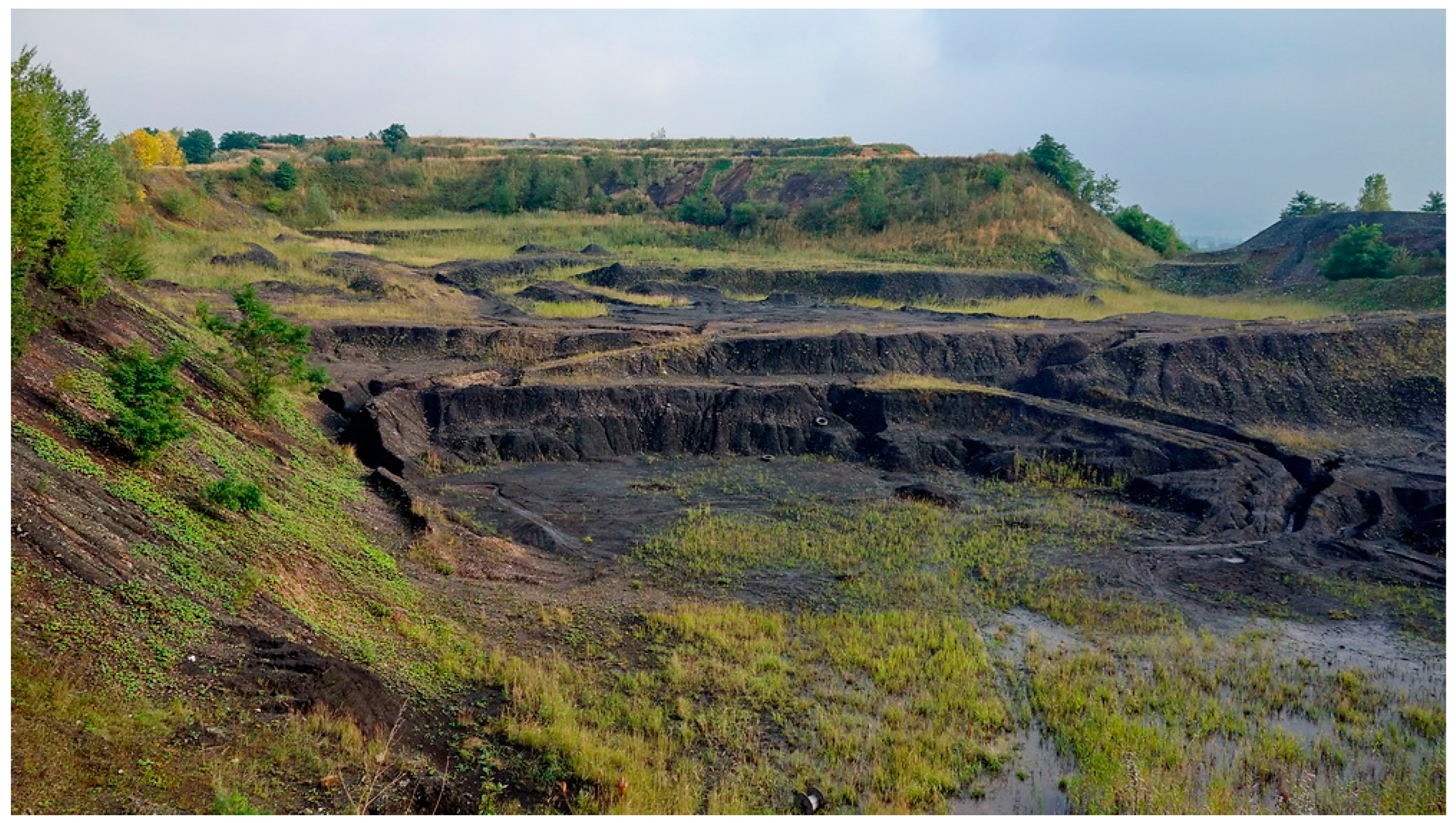
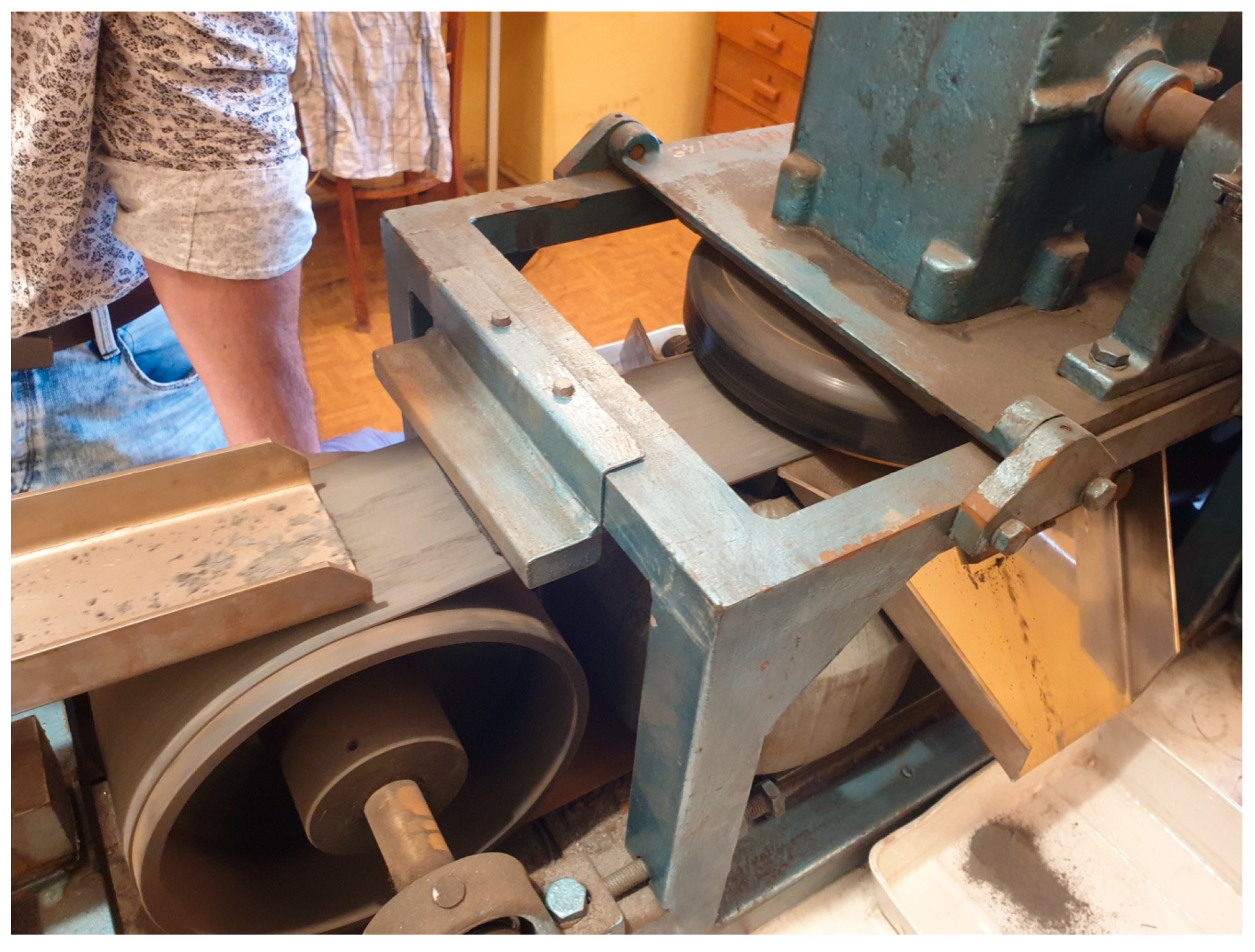
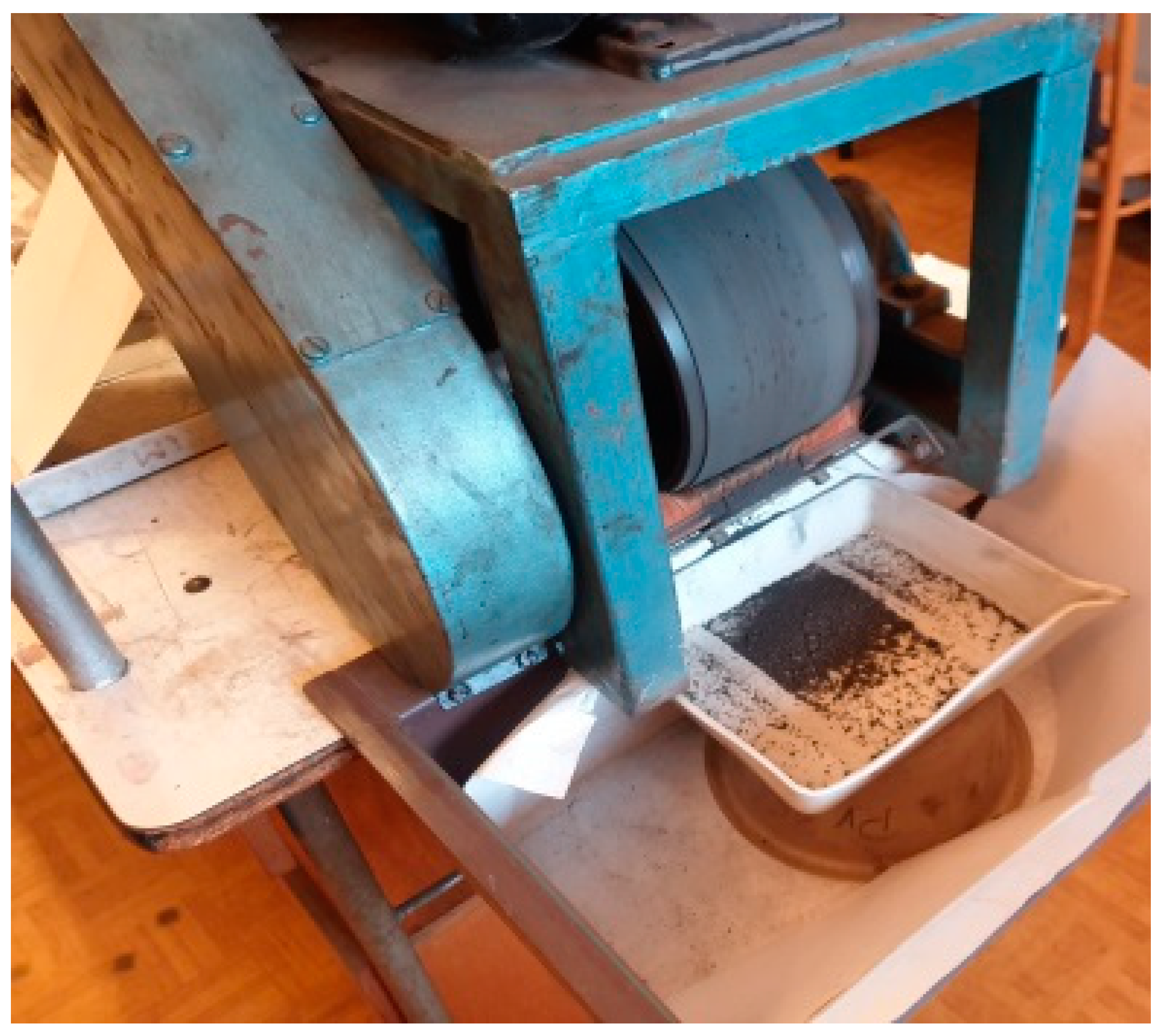
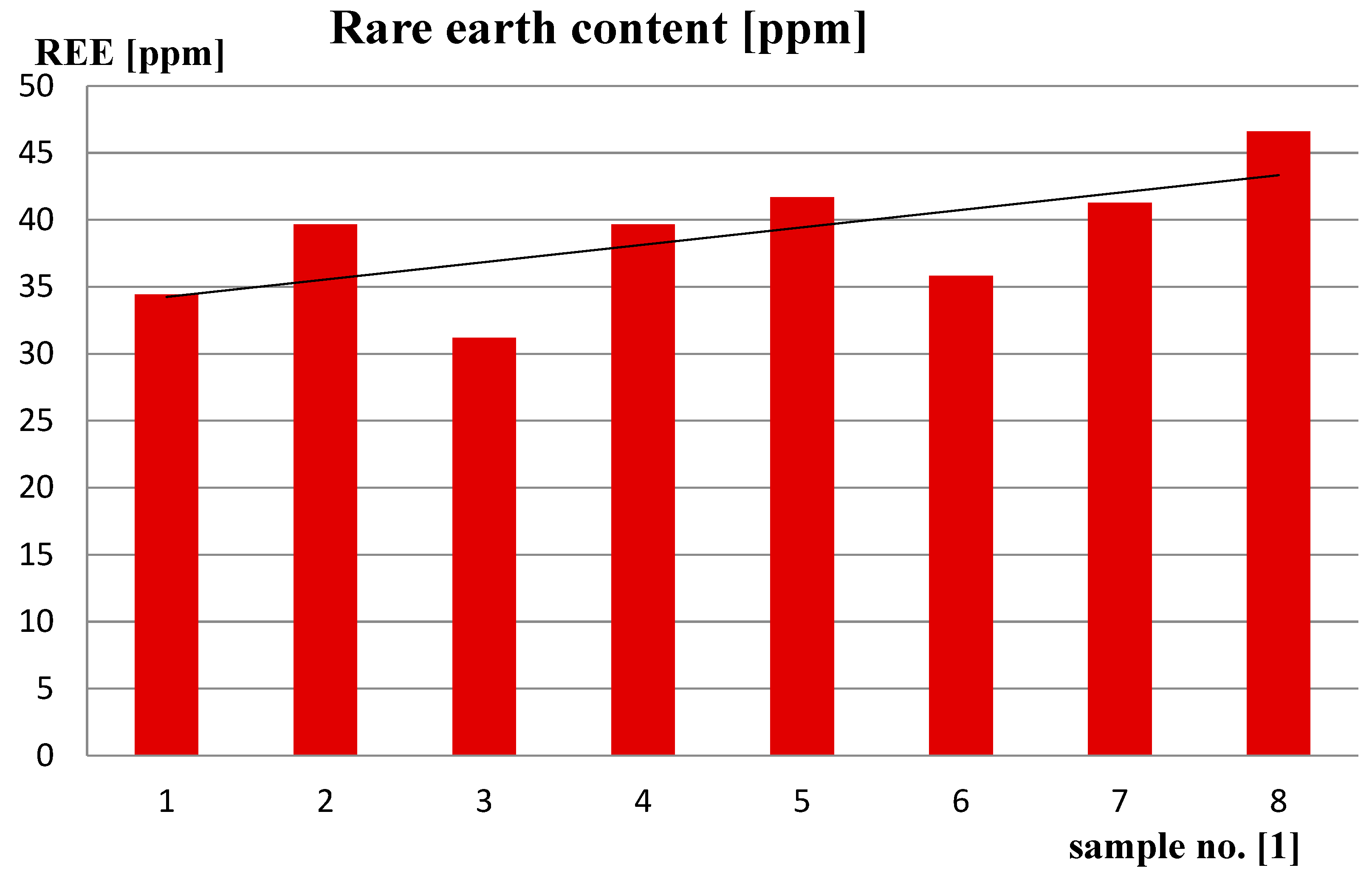
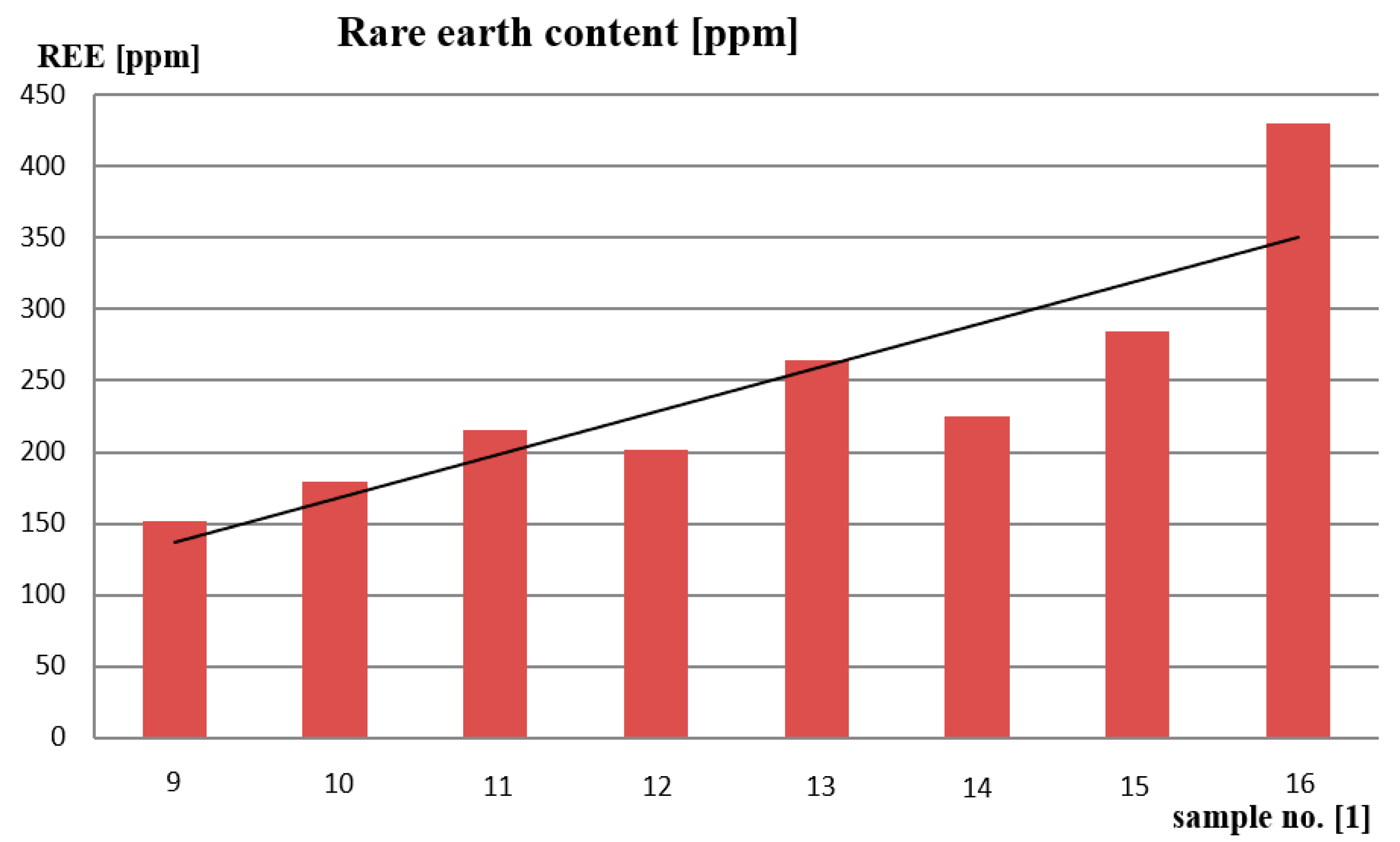
| Lp. | Number and Identification of the Sample | Grain Class Yield [%] |
|---|---|---|
| 1. | P8 – Coal slurries >2.0 mm | 3.6 |
| 2. | P7 – Coal slurries 2.0–1.0 mm | 2.1 |
| 3. | P6 – Coal slurries 1.0–0.5 mm | 11.3 |
| 4. | P5 – Coal slurries 0.5–0.25 mm | 15.3 |
| 5. | P4 – Coal slurries 0.25–0.125 mm | 20.5 |
| 6. | P3 – Coal slurries 0.125–0.063 mm | 13.2 |
| 7. | P2 – Coal slurries 0.063–0.045 mm | 3.6 |
| 8. | P1 – Coal slurries <0.045 mm | 30.4 |
| 9. | Total | 100 |
| Lp. | Number and Identification of the Sample | Grain Class Yield [%] |
|---|---|---|
| 1. | P16 – Basalt aggregate >2.0 mm | 14.0 |
| 2. | P15 – Basalt aggregate 2.0–1.0 mm | 2.0 |
| 3. | P14 – Basalt aggregate 1.0–0.5 mm | 5.8 |
| 4. | P13 – Basalt aggregate 0.5–0.25 mm | 8.8 |
| 5. | P12 – Basalt aggregate 0.25–0.125 mm | 12.2 |
| 6. | P11 – Basalt aggregate 0.125–0.063 mm | 21.1 |
| 7. | P10 – Basalt aggregate 0.063–0.045 mm | 31.0 |
| 8. | P9 – Basalt aggregate <0.045 mm | 5.1 |
| 9. | Total | 100.0 |
| Lp. | Number and Identification of the Sample | Grain Class Yield [%] |
|---|---|---|
| 1. | P17 - paramagnetic product with higher susceptibility, coal slurries | 0.46 |
| 2. | P18 - paramagnetic product with lowsusceptibility, coal slurries | 1.41 |
| 3. | Non-magnetic product, coal slurries | 98.1 |
| 4. | Summary | 100 |
| 5. | P19 - paramagnetic product with higher susceptibility, basalt aggregate | 7.3 |
| 6. | P20 - paramagnetic product with lowsusceptibility, basalt aggregate | 12.9 |
| 7. | Magnetically not susceptible product,basalt aggregate | 79.8 |
| 8. | Summary | 100 |
| Number and Identification of the Sample | Rare Earth Content [ppm]. | |||||
|---|---|---|---|---|---|---|
| P1 Grain class >2 mm |
Sc | Y | La | Ce | Pr | Lu |
| 2.35 | 2.36 | 2.08 | 1.86 | 1.93 | 2.11 | |
| Nd | Sm | Eu | Gd | Tb | ΣREE | |
| 1.93 | 1.92 | 2.44 | 2.18 | 1.85 | 34.44 | |
| Dy | Ho | Er | Tm | Yb | ||
| 2.64 | 1.86 | 2.54 | 1.86 | 2.53 | ||
| P2 Grain class 2–1 mm |
Sc | Y | La | Ce | Pr | Lu |
| 2.69 | 2.72 | 2.4 | 2.15 | 2.22 | 2.43 | |
| Nd | Sm | Eu | Gd | Tb | ΣREE | |
| 2.22 | 2.21 | 2.81 | 2.52 | 2.14 | 39.67 | |
| Dy | Ho | Er | Tm | Yb | ||
| 3.04 | 2.15 | 2.92 | 2.14 | 2.91 | ||
| P3 Grain class 1–0.5 mm |
Sc | Y | La | Ce | Pr | Lu |
| 2.11 | 2.14 | 1.89 | 1.69 | 1.75 | 1.91 | |
| Nd | Sm | Eu | Gd | Tb | ΣREE | |
| 1.75 | 1.74 | 2.21 | 1.98 | 1.68 | 31.2 | |
| Dy | Ho | Er | Tm | Yb | ||
| 2.39 | 1.69 | 2.3 | 1.68 | 2.29 | ||
| P4 Grain class 0.5–0.25 mm |
Sc | Y | La | Ce | Pr | Lu |
| 2.68 | 2.72 | 2.39 | 2.14 | 2.21 | 2.42 | |
| Nd | Sm | Eu | Gd | Tb | ΣREE | |
| 2.21 | 2.2 | 2.8 | 2.51 | 2.13 | 39.66 | |
| Dy | Ho | Er | Tm | Yb | ||
| 3.03 | 2.28 | 2.91 | 2.13 | 2.9 | ||
| P5 Grain class 0.25–0.125 mm |
Sc | Y | La | Ce | Pr | Lu |
| 2.84 | 2.87 | 2.53 | 2.26 | 2.34 | 2.47 | |
| Nd | Sm | Eu | Gd | Tb | ΣREE | |
| 2.34 | 2.33 | 2.96 | 2.65 | 2.25 | 41.69 | |
| Dy | Ho | Er | Tm | Yb | ||
| 3.2 | 2.26 | 3.08 | 2.25 | 3.06 | ||
| P6 Grain class 0.125–0.063 mm |
Sc | Y | La | Ce | Pr | Lu |
| 2.44 | 2.47 | 2.17 | 1.94 | 2.01 | 2.11 | |
| Nd | Sm | Eu | Gd | Tb | ΣREE | |
| 2.01 | 2 | 2.55 | 2.28 | 1.93 | 35.83 | |
| Dy | Ho | Er | Tm | Yb | ||
| 2.75 | 1.94 | 2.65 | 1.94 | 2.64 | ||
| P7 Grain class 0.063–0.045 mm |
Sc | Y | La | Ce | Pr | Lu |
| 3.1 | 3.19 | 2.6 | 3 | 2.2 | 2.31 | |
| Nd | Sm | Eu | Gd | Tb | ΣREE | |
| 2.53 | 2.22 | 2.72 | 2.54 | 2.05 | 41.27 | |
| Dy | Ho | Er | Tm | Yb | ||
| 3.0 | 2.06 | 2.86 | 2.04 | 2.85 | ||
| P8 Grain class <0.045 mm |
Sc | Y | La | Ce | Pr | Lu |
| 3.47 | 4.12 | 3.04 | 4.29 | 2.39 | 2.38 | |
| Nd | Sm | Eu | Gd | Tb | ΣREE | |
| 3.19 | 2.45 | 2.88 | 2.81 | 2.13 | 46.61 | |
| Dy | Ho | Er | Tm | Yb | ||
| 3.12 | 2.16 | 3.05 | 2.11 | 3.02 | ||
| Number and Identification of the Sample | Rare Earth Content [ppm]. | |||||
|---|---|---|---|---|---|---|
| P9 Basalt aggregate >2.0 mm |
Sc | Y | La | Ce | Pr | Lu |
| 5.83 | 9.26 | 30.64 | 58.3 | 6.22 | 0.14 | |
| Nd | Sm | Eu | Gd | Tb | ΣREE | |
| 22.75 | 4.33 | 1.47 | 5.38 | 0.6 | 151.23 | |
| Dy | Ho | Er | Tm | Yb | ||
| 3.08 | 0.54 | 1.41 | 0.18 | 1.1 | ||
| P10 Basalt aggregate 2.0–1.0 mm |
Sc | Y | La | Ce | Pr | Lu |
| 7.67 | 10.84 | 38.08 | 69.02 | 7.14 | 0.17 | |
| Nd | Sm | Eu | Gd | Tb | ΣREE | |
| 26.13 | 4.99 | 1.68 | 6.23 | 0.69 | 179.78 | |
| Dy | Ho | Er | Tm | Yb | ||
| 3.5 | 0.61 | 1.58 | 0.21 | 1.24 | ||
| P3 Grain class 1–0.5 mm |
Sc | Y | La | Ce | Pr | Lu |
| 8.35 | 12.47 | 44.18 | 81.8 | 8.92 | 0.2 | |
| Nd | Sm | Eu | Gd | Tb | ΣREE | |
| 33.2 | 6.53 | 2.23 | 7.84 | 0.87 | 215.25 | |
| Dy | Ho | Er | Tm | Yb | ||
| 4.33 | 0.76 | 1.91 | 0.24 | 1.42 | ||
| P12 Basalt aggregate 0.5–0.25 mm |
Sc | Y | La | Ce | Pr | Lu |
| 6.08 | 10.65 | 41.3 | 80.82 | 8.38 | 0.16 | |
| Nd | Sm | Eu | Gd | Tb | ΣREE | |
| 30.94 | 5.95 | 2.03 | 7.11 | 0.75 | 201.68 | |
| Dy | Ho | Er | Tm | Yb | ||
| 3.77 | 0.66 | 1.62 | 0.22 | 1.24 | ||
| P13 Basalt aggregate 0.25–0.125 mm |
Sc | Y | La | Ce | Pr | Lu |
| 15.52 | 18.22 | 52.37 | 96.52 | 10.48 | 0.26 | |
| Nd | Sm | Eu | Gd | Tb | ΣREE | |
| 38.86 | 7.66 | 2.64 | 9.33 | 1.06 | 264.16 | |
| Dy | Ho | Er | Tm | Yb | ||
| 5.46 | 0.96 | 2.51 | 0.32 | 1.99 | ||
| P14 Basalt aggregate 0.125–0.063 mm |
Sc | Y | La | Ce | Pr | Lu |
| 17.03 | 16.42 | 42.89 | 80.12 | 8.67 | 0.25 | |
| Nd | Sm | Eu | Gd | Tb | ΣREE | |
| 32.46 | 6.54 | 2.24 | 7.97 | 0.92 | 225.14 | |
| Dy | Ho | Er | Tm | Yb | ||
| 4.68 | 0.82 | 2.12 | 0.28 | 1.73 | ||
| P15 Basalt aggregate 0.063–0.045 mm |
Sc | Y | La | Ce | Pr | Lu |
| 25.2 | 21.86 | 52.13 | 99.32 | 10.74 | 0.29 | |
| Nd | Sm | Eu | Gd | Tb | ΣREE | |
| 40.41 | 8.2 | 2.78 | 10.06 | 1.15 | 284.14 | |
| Dy | Ho | Er | Tm | Yb | ||
| 5.79 | 1.04 | 2.67 | 0.35 | 2.15 | ||
| P16 Basalt aggregate <0.045 mm |
Sc | Y | La | Ce | Pr | Lu |
| 21.85 | 31.37 | 82.89 | 165.06 | 17.53 | 0.42 | |
| Nd | Sm | Eu | Gd | Tb | ΣREE | |
| 61.93 | 12.02 | 4.08 | 14.55 | 1.62 | 430.08 | |
| Dy | Ho | Er | Tm | Yb | ||
| 8.12 | 1.45 | 3.73 | 0.5 | 2.96 | ||
| Lp. | Sample Identification |
Raw Material |
Paramagnetic Product with Higher Susceptibility | Paramagnetic Product with Lower Susceptibility | ||
|---|---|---|---|---|---|---|
| Rare Earth Content [ppm]. | Sample Number | Rare Earth Content [ppm]. | Sample Number | Rare Earth Content [ppm]. | ||
| 1. | Coal slurries |
263.8 | P17 | 40.45 | P18 | 36.29 |
| 2. | Basalt aggregate |
190.0 | P19 | 26.35 | P20 | 212.87 |
Disclaimer/Publisher’s Note: The statements, opinions and data contained in all publications are solely those of the individual author(s) and contributor(s) and not of MDPI and/or the editor(s). MDPI and/or the editor(s) disclaim responsibility for any injury to people or property resulting from any ideas, methods, instructions or products referred to in the content. |
© 2023 by the authors. Licensee MDPI, Basel, Switzerland. This article is an open access article distributed under the terms and conditions of the Creative Commons Attribution (CC BY) license (http://creativecommons.org/licenses/by/4.0/).





